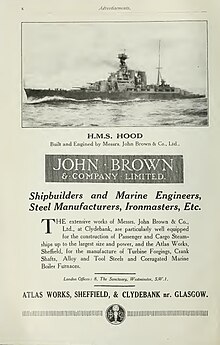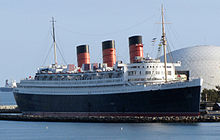John Brown & Company

John Brown and Company was a shipyard in Clydebank (Scotland). The company, which was founded in the mid-19th century, ceased operations in the early 1970s. John Brown & Co. was one of the most important shipyards in Europe and built many passenger and war ships that are still known today.
history
Start time
The company was founded in 1847 as J. & G. Thomson by shipbuilders James and George Thomson as a foundry in Anderston , Glasgow . The two brothers previously worked for the well-known engineer Robert Napier . The yard took in 1851 in Cessnock its operation, leaving the following year the first ship that The Jackal , from the stack . As early as 1854, the Jura , the first passenger ship for the Cunard Line , was delivered, for which the shipyard built almost all large passenger ships until it was closed. In 1867 the shipyard's first ship, Russia , was built and set a record.
move
In order to be able to build larger ships, the shipyard moved to Barns o 'Clyde (later Clydebank) near Dalmuir in 1871 . The steel manufacturer John Brown & Company from Sheffield took over the shipyard in 1899. In 1907 Sir William Arrol & Co. erected the 150- foot (45-meter) high tower crane Titan with a lifting capacity of 175 tons. At the beginning of the 20th century, the company became famous for its Brown Curtis turbines , which had originally been developed by the American company International Curtis Marine Turbine Co. New orders for large warships for the Royal Navy followed .
World wars
After the end of the First World War , the shipyard survived mainly through the construction of the two passenger ships Queen Mary and Queen Elizabeth for the Cunard White Star Line.
During World War II , John Brown & Company built warships.
post war period
After the war, numerous merchant ships were built to make up for wartime losses. At the end of the 1950s, the shipyard, like the rest of the British shipbuilding industry, came under financial pressure under pressure from international competitors. Assuming that it would receive a profitable new construction contract for passenger ships from the Cunard Reederei, the company's management followed a strategy of building cost-covering new buildings, such as the Kungsholm , in order to get over the crisis first. Due to rising costs and inflation losses, the company suffered such high losses that the company management could no longer rule out the closure of the uneconomical shipyard as early as the mid-1960s. The last order for a passenger ship, the Queen Elizabeth 2 , came from Cunard in 1964.
In 1968, as recommended in the Geddes Report , the shipyard became part of the Upper Clyde Shipbuilders company , which finally went bankrupt in 1971. The shipyard's last ships were four Clyde class bulk carriers , the last unit of which, the Alisa , was delivered to its client on December 26, 1973.
On the shipyard site in Clydebank, the Marathon Manufacturing Company (1972-1980) and Union Industrielle d'Entreprise (UIE) (1980-2001) built oil platforms for the North Sea oil fields until 2001.
The economically more successful John Brown Engineering Division was initially taken over by Trafalgar House and bought by Kvaerner in 1996 . This part of the company was later dismantled by Kvaerner and John Brown Hydrocarbons and Davy Process Technology were sold to Yukos . John Brown Hydrocarbons was resold to Chicago Bridge & Iron Company in 2003 and renamed first to CB&I John Brown and later to CB&I UK Limited.
The former shipyard with the listed crane "Titan" is to be rebuilt and revitalized.
Well-known ships from John Brown & Company
Royal yacht
Aircraft carrier
Battleships
Battle cruiser
- Inflexible
- Australia (1911)
- tiger
- Hood
- Repulse
Heavy cruisers
Light cruisers
- Southampton (1912)
- Southampton (1934)
- Fiji
- Enterprise
destroyer
Frigates
Escort destroyer
Amphibious landing craft
Passenger ships
- Carmania
- Aquitania
- Lusitania
- Avila
- Avelona
- Empress of Britain
- Queen Mary
- Queen Elizabeth
- Kungsholm
- Queen Elizabeth 2
See also
Web links
- Aerial view of the shipyard when the RMS Empress of Britain was launched (June 1930)
- Side of the Clydebank Restoration Trust (English)
- List of all ships built on the Clyde (English)
- Plan for the reconstruction of the former shipyard site (English)
- Early documents and newspaper articles on John Brown & Company in the 20th century press kit of the ZBW - Leibniz Information Center for Economics .
Footnotes
- ↑ a b c d e f g h i The Clydebank story (English)
- ↑ Shipbuilding Crisis BBC News, January 1, 2002 (English)
- ↑ Hansard Parliamentary Debate, June 4, 1971 (English)
- ↑ Clyde Waterfront Heritage: John Brown Shipyard ( Memento of the original from January 3, 2014 in the Internet Archive ) Info: The archive link was automatically inserted and has not yet been checked. Please check the original and archive link according to the instructions and then remove this notice.
- ^ Trafalgar acquires John Brown New York Times, May 8, 1986
- ↑ Kvaerner acquires Trafalgar The Independent, 5 March 1996 (English)
- ^ Attachments to Yukos APS Review, September 6, 2004
- ↑ CB&I acquires John Brown Hydrocarbons Businesswire, June 2, 2003 (English)
- ↑ Titan Clydebank Kran ( Memento of the original from May 7th, 2009 in the Internet Archive ) Info: The archive link was automatically inserted and not yet checked. Please check the original and archive link according to the instructions and then remove this notice. (English)
Coordinates: 55 ° 53 '52 " N , 4 ° 24' 15.9" W.






